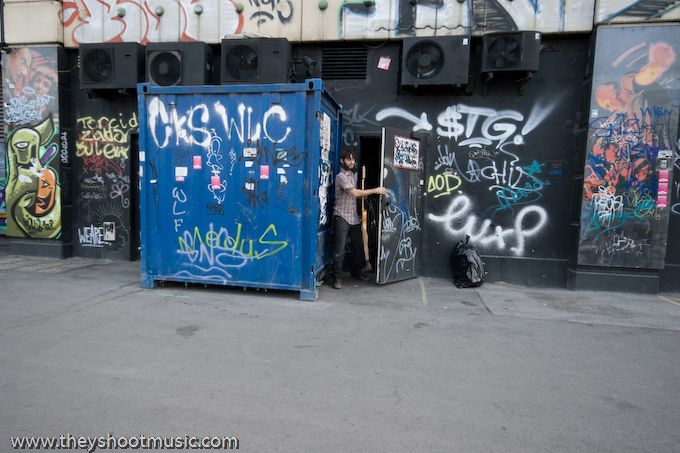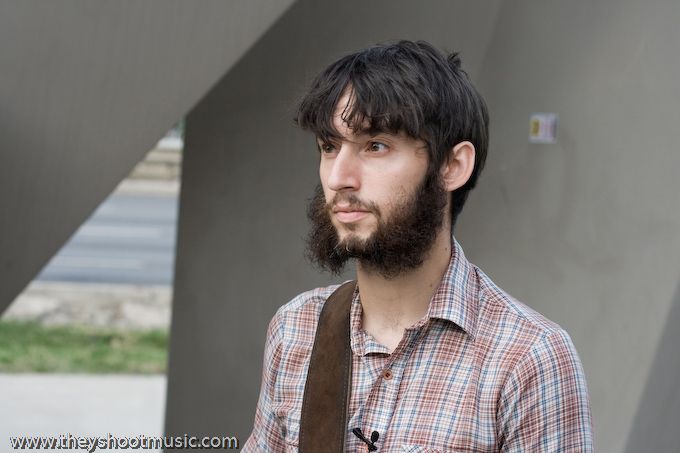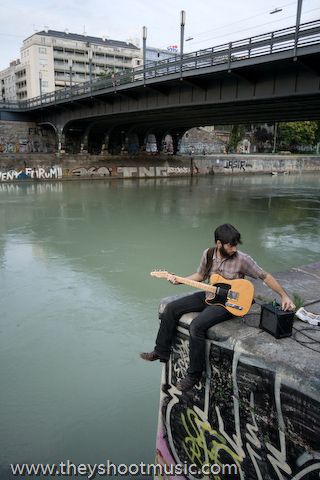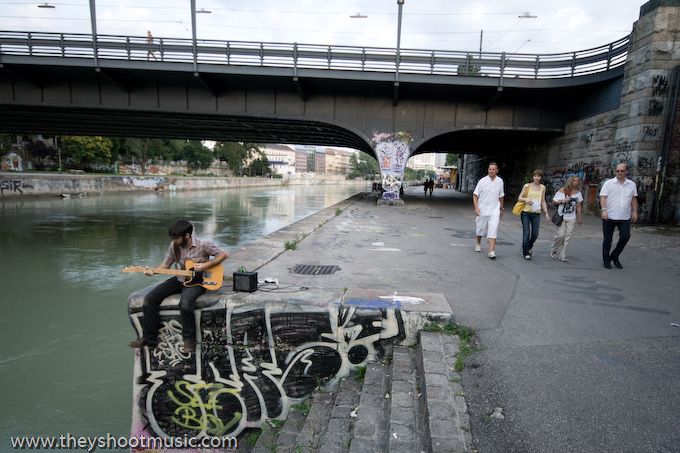Murder By Death
Augartenbrücke, Ringstraße Schottenring, 2008
When Indiana-based four-piece-band Murder by Death stops by Vienna after coming all way down with their van from Paris, we meet with the band’s very good-natured singer and guitarist Adam Turla who gives us a an insight in their touring life (neither high travel expenses nor swallowing of bugs can destroy his humor). After admitting that he feels a little awkward performing just by himself outside of the concert venue when people pass by (“It’s intimidating”), Adam sits under the bridge next to the riverbank with his feet dangling down or hides behind a concrete monument enclosed by roaring cars. Once Turla starts his dark guitar play and raises his gnarly and deep voice, the Acheronian spirit of Murder by Death spreads beyond any timidness. The band’s grim sound of Americana noir, punk rock and alternative country deals with western influences (last record “Red Of Tooth and Claw” containing the instrumental song “Theme for Ennio Morricone”) and topics as sin, lust, betrayal and “Homer’s Odyssey of revenge, only without the honorable evil”, as Adam describes the concept of their last album. The dismalness of the songs is swept away by a friendly smile, a polite “thank you” after the shooting. It is the day before Adam’s birthday that he will spend with his mother in Switzerland.
- Photography
- Simon Brugner
- Artist
- Murder By Death







Augartenbrücke
Augartenbrücke (Augarten bridge) is one of twenty bridges across the Donaukanal, a 17 kilometres long side arm of the river Danube in Vienna. The bridge connects the second with the ninth district and was first built in 1782 in order to make newly opened Augarten, a nearby park, easily accessible from the Inner City. Since then the bridge has been torn down and destroyed several times, the last of which was at the end of the Second World War in 1945 by the Germans. Less than one year later the unadorned steel bridge was reopened to people, cars and tramways. Among young people Augartenbrücke is know for being the common way to Vienna’s most popular music club Flex. Just take the stairs down to the Donaukanal on the right side of the southern end of the bridge and you will be captured by the fairy lights and the club tunes.
Ringstraße Schottenring
Ringstraße is a one-way-road leading ringlike around the Inner City of Vienna. On its 5.2 kilometres Ringstraße is lined with several of the most famous historic buildings and sights of the city, such as the State Opera, the Parliament, the Town Hall, the Imperial Palace, the University and several museums. The majority of the buildings along the road were erected between 1860 and 1870 and coined the term of Ringstraßen style architecture, which is a variety of Historism. Starting from the 13th century the Inner City was encircled by a fortification wall and on its outside a 500-meter-broad glacis slope. In 1857 the fortification was razed and the growing outer districts suburbanised. In between, though, there was still enough space left to build prestigious palaces, establish green spaces like Stadtpark, Volksgarten or Rathauspark close to the center and construct the almost circular Ringstraße, which was inaugurated by Emperor Franz Josef on May 1st 1865. Each part of the road has a different name. The term Schottenring derives from a close-by monastery which was founded in 1155 by Irish monks who were called Scots, following the latin “Scotia Major” for Ireland.